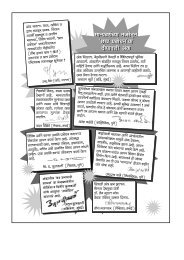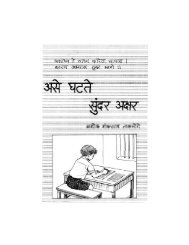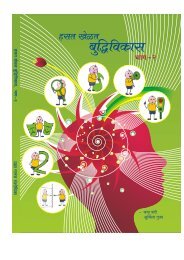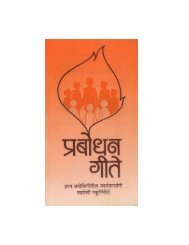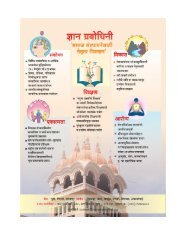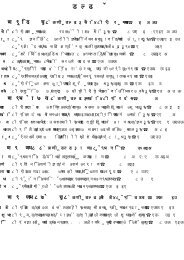3 D Magic
3 D Magic
3 D Magic
Create successful ePaper yourself
Turn your PDF publications into a flip-book with our unique Google optimized e-Paper software.
3 D <strong>Magic</strong><br />
(40 Geometrical Models)<br />
Author<br />
Dr. D. V. Navathe<br />
Educational Activities Research Centre<br />
Sixth Publication<br />
Jnana Prabodhini<br />
510, Sadashiv Peth, Pune 30.
3 D <strong>Magic</strong><br />
(Diagrams & method of making 40 Geometrical Models)<br />
Publisher<br />
Shri. V. S. Deshpande<br />
Secretary, Jnana Prabodhini, Pune 30.<br />
Printer<br />
Editor, Chhatra Prabodhan, Pune 30.<br />
Typesetting<br />
Chhatra Prabodhan, Jnana Prabodhini, Pune 30.<br />
Cover & Internal Design<br />
Shri. Satish Deshpande, Pune.<br />
Diagrams<br />
Swapna Deshpande, Pune.<br />
Model Photography<br />
Shri. Bharat Ketkar, Pune.<br />
© all rights with Publisher<br />
First Edition : Rashtriya Saur Vaishakh 14, Sake 1925, 30 April 2003/ 1000 Copies<br />
Second Edition : Rashtriya Saur Ashadh, Sake 1927, July 2005/ 1000 Copies<br />
Price : Rs. 80/-
Contents<br />
Preface<br />
The author speaks<br />
Part I - Introducing the requirements<br />
Part II - Basic Models (15)<br />
Part III - Balls (10)<br />
Part IV - Stars (11)<br />
Part V - Miscellaneous (4)<br />
Index I - Typewise models<br />
Index II- Difficulty levelwise models<br />
Index III - Timewise models<br />
Sample Paper
The Author speaks<br />
Mathematics is a very important subject in the school curriculum. Geometry is a part of that<br />
subject. It is observed that if it is taught properly, students do get interested in it; they learn to think<br />
consistently and to present their thoughts in an orderly manner. Students also like to draw attractive<br />
and proportionate figures for theorems in geometry. This builds up a mindset to do anything and<br />
everything clearly, in proportion and beautifully.<br />
Geometrical figures are to be drawn on paper only in a single dimension. However,<br />
once they are actually seen in three dimensions right before one's eyes, a liking is<br />
developed to make their models. If this liking is nurtured as an art or as a hobby, many<br />
beautiful and attractive models can be made from paper. They can contribute a lot to the<br />
happiness in life.<br />
For last few years, I have been teaching how to make some simple, three-dimensional<br />
models in geometry to boys and girls in Jnana Prabodhini.<br />
While making these models, the necessary figures must be drawn very meticulously,<br />
in exact measures. Even a small mistake of one millimeter cannot be tolerated. That<br />
mistake may result in making the model graceless and deformed. Moreover, only the<br />
person who makes it can pick up the mistake. Therefore, he feels like correcting it. After<br />
correction, if folded and pasted at right places, the model that gets ready pleases the<br />
maker as well as the spectator.<br />
Since this hobby complements the studies, we started teaching it to students of standards<br />
IX and X. It was included as an optional subject in hobby classes.<br />
This art of making three dimensional models was first practiced by Plato in Greece. It<br />
is learnt that Plato made six kinds of models. Records are found that triangles, squares,<br />
pentagons and hexagons were later joined in 13 different but symmetrical ways by<br />
Archimedes and his disciples.
It is planned, first to teach the schoolchildren a basic, preparatory model. From the same model<br />
several different models can be made. By now, the number of models so developed has increased<br />
tremendously. Some of these models have been used to make lanterns during Diwali. Every Diwali<br />
issue of "Chhatra Prabodhan" carries a "recipe" for a new lantern.<br />
We received several inquiries from local and out-of-station schools about the syllabus and teaching<br />
methodology of this subject. Hence, we thought of writing a book and this is it ! The book first<br />
carries a diagram of a model and then an explanation of how to make the model from the same.<br />
First it is necessary to draw the diagram in the exact proportion you want. Then score the lines to<br />
be folded with a blunt-edged knife or a pin. Cut off the whole diagram with a pair of scissors. The<br />
model will be ready when you fold at the right places and apply gum. It is our experience that if every<br />
fold is sharp, if care is taken not to stain the paper with gum and if the right angles are neat, the model<br />
turns out to be graceful and beautiful. You can also try the models and enjoy the pleasure of creation.<br />
In the production of this book, all the work relating to drawing the diagrams and trying out the<br />
recipe given is done by two of my students Mrudula Gokhale and Kalyani Deo. I thank them for that.<br />
The same model can be made by different methods; e.g. a cube. The book has only one method.<br />
It is simple to teach and saves paper. Therefore, it is included in the book.<br />
Most of the models of the Archimedes group turn out to be round shaped. They use the<br />
triangle, square, pentagon and hexagon only. While sticking these, one has the choice to<br />
apply the tape to either the triangles or squares. The model will get a good round shape if<br />
increased from all sides. Its beauty will increase if different shapes are coloured differently.<br />
While making the models given in the book, if someone thinks of something new and if a<br />
new model is created, I will feel the joy of fulfillment.<br />
- Dada Navathe



